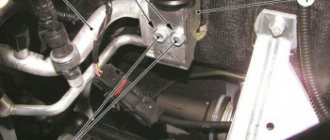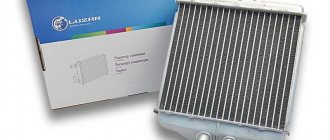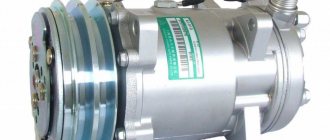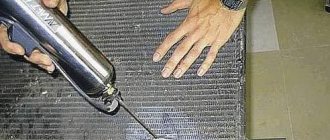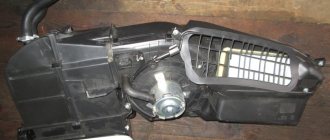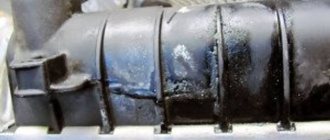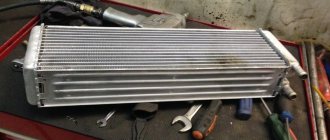In this article we will discuss the topic of replacing the air conditioner radiator. Let's talk about what to watch out for during this process, as well as what to do after the replacement. Let's look at soldering and filling in detail.
Nowadays it is difficult to imagine a car that does not have air conditioning or climate control. In this case, it seems that the car is very cheap or old.
After the collapse of the Soviet Union, in the 90s, a massive influx of foreign cars began on the domestic market. Then it seemed that its presence was an additional luxury that not everyone could afford, because its maintenance costs a lot of money.
But times are changing, and it is very difficult to imagine a car today that is not equipped with air conditioning or climate control. For us this has already become the norm. We don’t value these systems as much as we used to, and we only learn about breakdowns in the summer, in extreme heat.
Car air conditioner device
Any air conditioner is similar in design to a conventional refrigeration system. It is a closed circuit along which freon moves. During circulation, freon changes its state of aggregation from liquid to gaseous and back.
Main components and operating principle of the air conditioning system
The most important components of the air conditioning system are:
- compressor;
- condenser (also known as an air conditioner radiator) with a fan;
- receiver-dryer;
- pressure line (thin hot or warm tube);
- thermostatic valve;
- evaporator;
- evaporator fan;
- low pressure line (wide cold pipe).
When the air conditioner is turned on, a pulley driven by the engine using a belt begins to rotate the compressor. The latter serves to compress gaseous freon, which becomes very hot. Next, the heated freon enters the air conditioner radiator, where it is cooled using a fan and incoming air flow. When cooled, freon turns into a liquid state and in this form enters the receiver-dryer, where it is cleaned of impurities, dirt and wear products. From the dryer, liquid freon flows through a thermostatic valve into the evaporator. This valve regulates the supply of liquid gas depending on the filling and temperature of the evaporator. The freon enters the evaporator very cold. With the help of a fan, cold air enters the cabin, and freon is returned to the compressor.
Fundamentally, the air conditioning circuits in cars of different models are no different
Location and purpose of the air conditioner radiator
The air conditioner radiator is the largest component in the system. It is in it that the freon is cooled. It is usually located at the front of the car directly in front of the engine cooling radiator. This arrangement allows for efficient cooling of freon while driving. However, it also makes the air conditioner radiator a rather vulnerable unit. Therefore, incorrect operation of the air conditioner is most often associated with a malfunction of the condenser.
Reasons for failure of the air conditioner radiator
Symptoms of a malfunctioning air conditioner radiator are quite monotonous:
- the air is not cooled enough;
- the air is not cooled;
- The air conditioner only works while driving;
- When you stop, warm air comes out of the air ducts.
The reasons for the failure of the air conditioner radiator can be different:
- condenser clogging with dirt, dust, poplar fluff, etc.;
- corrosion and mechanical damage to the radiator and high and low pressure lines;
- internal clogging of the air conditioning system and obstruction of the highways;
- wear of rubber gaskets in joints;
- excessive pressure when the required amount of freon is exceeded when refilling.
How important is it
In addition to a comfortable ride, the air conditioning system increases the value of the vehicle. Its good condition is not only the key to the effective functioning of temperature control, but also to the normal condition of the people in the car.
Besides comfort, having a working air conditioning system increases the market value of your car. The air conditioner must be maintained in full working order. Some systems mix hot and cold air to achieve the required air temperature. In these cases, if the air conditioning system fails, not only will cold air stop flowing, but air temperature control will also completely fail.
Air conditioner radiator diagnostics
Most often, air conditioner malfunctions are associated with a violation of the tightness of the circuit. Leaks can occur both on the condenser itself and on the lines. But before looking for a leak using special means, you should conduct an external inspection of the radiator. If it is simply clogged with dirt, in some cases you can limit yourself to cleaning.
A lot of dirt accumulates in the air conditioner radiator
In addition, upon inspection, mechanical damage to the radiator or pipes may be detected. In this case, it is no longer possible to do without repairing or replacing the unit. Penetrating corrosion of the condenser clearly indicates the need to replace it.
If there are no external signs of breakage or blockage, special tools should be used to detect leaks. There are two ways to find holes in your air conditioning system: using a leak detector and using an ultraviolet dye.
Diagnosis using a leak detector
A leak detector is used in most car repair shops. It detects the smallest particles of freon in the air and gives a sound or light signal. The higher the gas concentration, the more intense the signal. Modern leak detectors are extremely sensitive and can detect even the smallest gaps in the condenser, connections or lines.
The leak detector can detect freon even at low concentrations
Leak detectors are sold in car dealerships. The cost varies from 3.5 to 20 thousand rubles.
Video: diagnosing the air conditioning system using a leak detector
Diagnostics using ultraviolet dye and lamp
In the absence of a leak detector, gaps can be detected using a special dye and an ultraviolet lamp.
Using an ultraviolet lamp you can find leaks throughout the entire circuit of the air conditioning system
To detect a leak, when filling the air conditioner with freon, you need to add a special dye that glows under an ultraviolet lamp. After this, turn on the air supply for a few minutes. In areas of leakage, the dye will come out along with the freon, and the gaps will become visible under ultraviolet light.
Under an ultraviolet lamp, gaps can be detected by green smudges
Diagnostic results
Based on the diagnostic results, it becomes clear how exactly the problem should be eliminated. If there are few places where freon leaks from the condenser, and their sizes are small, the radiator does not need to be replaced, but rather limited to repairs. However, if the line is damaged, and not the condenser itself, it is better to replace it. If major damage to the air conditioner radiator is detected, as well as if the holes are caused by corrosion, the unit should be replaced with a new one.
Leak test
After repairing the damage, the radiator must be checked for leaks. Here's how it's done:
- All additional radiator pipes are carefully sealed (the plugs for them can be cut from a piece of rubber).
- Water is poured into the main pipe. So that the radiator is filled to the top.
- Next, the device should be placed on a dry surface and left there for 30–40 minutes. If after this time no water appears under the radiator, it is sealed and can be installed in the car.
A second test option is also possible, using air:
- You need to take a container into which the radiator can easily fit (a medium-sized basin is best for this).
- The container is filled with water.
- The radiator pipes are clogged with plugs. A regular car pump is connected to the main pipe (you can use an adapter for the connection, and if you don’t have one, the hose is simply wound to the pipe with electrical tape).
- Using a pump, excess pressure is created in the device.
Escaped air bubbles indicate that the radiator is not sealed. - The radiator inflated with air is placed in a basin of water. If no escaping air bubbles are visible anywhere, the device is sealed.
Replacing the air conditioner radiator
When replacing the condenser, the tightness of the air conditioning system will be broken, and the old freon will have to be drained. Therefore, before starting work, you should purchase the required amount of refrigerant and equipment for charging.
To replace the radiator you will need:
- wrenches (spanners, TORX, hex);
- station with hoses and pressure gauges;
- Vacuum pump;
- freon bottle.
It is very important to monitor the air humidity in the room where the replacement is being carried out. The ingress of water into the refrigerant, even in small quantities, can accelerate wear of the entire system.
Procedure for replacing an air conditioner radiator
The air conditioning radiator is installed differently on all cars. However, in most cases, the dismantling process is similar, and the differences appear only in the details. In its most general form, the radiator replacement algorithm is as follows:
- To provide access to the air conditioner radiator, remove the engine protection, front bumper and false radiator grille.
- If there is freon left in the system, release it through the nipple on the low pressure line. Be careful, freon leaving the system can cause frostbite on your fingers.
- Unscrew the tubes from the radiator and seal them with tape. Do not allow dirt, dust or moisture to get into the lines.
- Remove the condenser from the mounts connecting it to the body or radiator of the internal combustion engine. It is better to replace all rubber gaskets in the connections with new ones.
- Install a new radiator.
- Next, you should evacuate the air conditioning system by connecting the vacuum pump to the service port of the air conditioner through hoses equipped with a pressure gauge. The pumping process lasts 10–20 minutes.
- Fill the air conditioner with the required amount of freon.
- Check the system for leaks.
Video: replacing the air conditioner radiator of an OPEL Vectra
"Niva Chevrolet"
Replacing the radiator (Niva Chevrolet with air conditioning) is performed as follows. The first step is to drain the antifreeze - you need it to come out completely. To do this, blow into the expansion tank. Next, remove the ground terminal from the battery and dismantle the glove compartment. After this, the center console is removed along with the radio.
The next step is to snap off the body panels from each of the A-pillars. The decorative panel from the center console on the driver’s side is also removed, and the instrument cluster is disconnected. It is necessary to loosen the fasteners of the panel where the gearshift lever is, and the two self-tapping screws that are closest to the panel must be completely unscrewed. Then the steering column cover is removed, and along with it the steering column switches, and the panel mounting bolts are unscrewed. Remove the climate system handles and dismantle the heater control unit. Next, the steering column is unscrewed and lowered onto the driver's seat. After this, you can remove the air ducts behind the dashboard, remove all the cables and the dashboard frame. Then unscrew the bolts that hold the metal frame of the panel and remove it. Next, the housings of the evaporator and radiator of the stove will be visible. They are connected - they need to be separated. After successfully replacing the element, assembly must be carried out in the reverse order.
So, we found out how to replace an air conditioner radiator with your own hands.
Source
Repair, cleaning and flushing of the air conditioner radiator
The air conditioner radiator is far from the cheapest spare part. Therefore, in case of minor damage, it is easier to repair it than to replace it. In cases where the malfunction is caused by internal or external contamination, cleaning or flushing may be sufficient.
Repairing leaks
Small holes in the radiator can be filled with epoxy resin, after first cleaning the damaged areas from contaminants. Epoxy copes well with temperature changes, but the results of such repairs are usually temporary.
As an alternative, you can use a special powder sealant for radiators. It is sold in auto parts and automotive chemical stores.
The sealant is used as a quick-acting remedy for very small leaks
Instructions for using sealants are similar and look something like this:
- Dry the radiator.
- Pour sealant into the condenser.
- Fill with hot water.
- Drain the water and wait (waiting time depends on the product used).
The sealant must be used carefully and strictly in accordance with the instructions. Improper use can lead to clogging of the entire air conditioning system.
Air conditioner radiator soldering
Almost all air conditioner radiators are made of aluminum. This metal can only be properly soldered with argon. Argon soldering is used for repairing refrigeration units and household air conditioning systems. Therefore, to repair the air conditioner radiator, you can contact refrigerator service specialists.
The only way to reliably seal an air conditioner radiator is with argon.
Soldering yourself without having argon welding skills is not recommended. Yes, and you can’t do it without special equipment.
External cleaning of the air conditioner radiator
The outer surfaces of the condenser must be periodically cleaned from dirt and dust. It is better not to wait for problems to appear in its operation, but to flush the radiator as it becomes dirty.
You can flush the radiator with water without removing it from the car.
On most cars, when cleaning the air conditioner radiator, you can do without dismantling it. However, usually, in order to get to the rear wall of the condenser, you have to remove the engine radiator. After removing the front bumper, radiator grille and the cooling system radiator itself, you can begin flushing the condenser. This is done with pressurized steam or water. The water pressure should not be too high so that the aluminum honeycomb of the radiator remains intact. It is better to start flushing from the rear side, facing the engine.
Washing the internal surfaces of the air conditioner radiator
To prevent internal clogging, the air conditioner radiator must be flushed periodically. For this purpose, special chemicals are used.
A special cleaning agent can be purchased at any automotive chemical store.
It is recommended to flush the inside of the air conditioner radiator as follows:
- Disconnect the air conditioner radiator from the system, first releasing all the freon.
- Following the instructions, dissolve the reagent in warm water and pour the solution into the condenser.
- Seal all openings on the radiator.
- Leave the radiator for a while. The duration of cleaning should be indicated in the instructions for the product used.
- Drain the solution and rinse the radiator with water several times.
- Dry the radiator.
- Attach the line pipes to the radiator.
- Evacuate the system and recharge the air conditioner.
Cleaning the air conditioning system
The air conditioner is usually refilled after winter; at the same time it is recommended to clean the air conditioner. To do this, use special foam, sold in cans.
Using foam you can quickly and effectively clean your air conditioning system.
The cleaning procedure is as follows:
- Remove the flexible hose from the drainage pipe (the pipe is located at the bottom, behind the plastic panel in front of the passenger seat).
The drainage pipe is located below the plastic panel in front of the passenger seat - Install the hose from the cleaner onto the drain pipe and pull it upward as far as it will go.
A hose from the cleaner is installed on the drain pipe - Prepare an empty container to collect foam.
- Start the engine.
When cleaning the radiator, the used foam is collected in a separate container and disposed of - Turn on the air conditioner in air recirculation mode.
The heating and air conditioning control unit is located on the front panel - Leave the vehicle and let the engine run for about 15 minutes. During this time, the foam should penetrate into all cavities not only of the heater, but also of the stove radiator.
To clean the radiators of the air conditioner and heater, their dismantling is not required. After carrying out the work, experts recommend replacing the cabin filter.
Video: cleaning the air conditioner radiator with special foam
Refilling the air conditioner with freon
After repair, replacement or internal flushing of the radiator, the system must be refilled with coolant. Moreover, recharging the air conditioner is necessary, even if it is working properly. The norm is an annual leak of 15% of the total freon volume. Therefore, the air conditioner needs to be refilled every 3 years.
Types of freon
Freon is used as a refrigerant. But there are quite a lot of varieties of this gas. Thus, in cars manufactured before 1992, R-12 freon was used. In 1992, scientists proved its harmful effects on the ozone layer of the atmosphere, and R-12 was banned. Air conditioners began to be filled with R-134a freon.
Freon is usually sold in convenient cylinders of different capacities.
Today, both types of freon are on sale. It is important to know which one is suitable for your car. If the car was manufactured in 1992–1993, that is, during the transition period, there is a sticker on the inside of the hood that indicates which freon should be used and in what quantity.
When refilling the air conditioner, it is recommended to add oil to the system through the crankcase. However, determining the required amount of oil is not easy. Therefore, it is better to buy freon already diluted with oil.
Equipment for refilling air conditioner with freon
Professional car repair shops have special filling stations for air conditioners. They automatically determine the required amount of refrigerant, evacuate the system and charge it. This, however, does not mean that it is impossible to charge the air conditioner yourself.
Professional stations for refilling air conditioners are multifunctional, but not cheap
To refuel the air conditioner in a garage you will need:
- Vacuum pump;
- weather station or hose with pressure gauge;
- hoses and adapters for connection to the air conditioner;
- a cylinder with the required amount of freon.
The station (or valve with pressure gauge) can be immediately connected to hoses and adapters, assembling a refueling installation.
On one side the unit is connected to a refrigerant cylinder, on the other - to an air conditioner
Procedure for refilling the air conditioner with freon
When refilling the air conditioner, you should be extremely careful and precise, and also carefully monitor the readings of the pressure gauges.
The air conditioner can be recharged outside
Algorithms for refilling air conditioners of cars of different brands and models differ slightly. In any case, you will have to perform the following steps.
- If the air conditioner has not worked for a long time, be sure to carry out vacuumization using a vacuum pump.
- Remove the plastic plug located on the return line.
- Connect the refrigerant cylinder to the charging unit.
- Using the adapter, connect the filling unit hose to the connector.
- Start the engine and raise the speed to 1500.
- Turn on maximum air recirculation.
- Start applying freon, maintaining the speed at the same level.
- Apply freon until the pressure gauge reading reaches 280 kPa.
- Check if cold air is entering the cabin. At maximum modes, its temperature should not exceed 10 degrees.
Video: refilling the air conditioner with your own hands
Thus, it is quite simple to repair and replace the air conditioner radiator with your own hands. You just need to be careful and carefully follow the recommendations of professionals.
Self-repair and replacement of the fuel pump of a VAZ 2106/07 car
Diagnosis of faults, repair and replacement of the Chevrolet Lanos heater radiator with your own hands
